Menu

Loans for renewable energy gear can be as low as $500 or reach several million dollars. This wide range shows how big renewable energy is in our lives. It’s crucial in homes, businesses, and industries. By 2001, the India Renewable Energy Development Agency (IREDA) had given out over $400 million in loans. This helped create more than 1600 megawatts of new green power.
Renewable energy comes from the wind, sun, and warmth in the Earth. These sources never run out and provide different ways to make energy. Take solar energy, for example. It uses both active methods like solar panels and passive ways like clever building designs to catch the sun’s energy. Wind farms with big turbines make electricity without hurting the environment. In places like Iceland, the heat underground powers many buildings.
Biomass energy is from plant or animal matter. It can make heat or electricity. Hydroelectric power uses water flow to create energy, often with dams. These methods are key in making our energy system kinder to Earth. Governments offer help to make this shift easier. They give out money, fewer taxes, and low-interest loans, especially during the 1980s and 1990s. Today, over 30 U.S. states cut property taxes for homes using green power. This encourages more people to use these technologies.
Renewable energy is key in tackling climate change and moving to sustainable energy. By using environmental-friendly energy equipment, we can reduce our reliance on fossil fuels. This shift not only cuts down carbon emissions but also saves natural resources for the future.
Renewables are crucial for moving towards low-carbon energy solutions. They currently supply a big part of our energy needs. For example, they cover Electricity: 65%, Heat: 26%, and Transportation: 9%.
Using sources like solar, wind, and biofuels helps lower greenhouse gases. It fights against climate change.
Countries like China and the US are at the forefront. China produces 34% of the world’s renewable energy. The US gives 10%. Norway leads in the use of renewable energy, covering 72% of its energy needs.
Our main goal is to cut global warming by shifting to renewable energy. It’s critical to focus not only on making electricity but also on transport and heating.
| Country | Renewable Energy Production (%) |
|---|---|
| China | 34% |
| United States | 10% |
| Norway | 72% |
Expanding the use of renewable energy equipment in all sectors needs big plans. We must overcome barriers like tough permissions and fossil fuel competition. But, help from governments, lower costs, and business goals can drive this change. For example, in the US, there are credits like the Production Tax Credit (PTC) and Investment Tax Credit (ITC) to help start new renewable projects.
Looking at the green effect of renewable energy is very important. Most of these options cause much less harm than using fossil fuels. By supporting new ideas and good policies, we can find better and greener energy solutions.
Solar energy is quickly becoming a top renewable energy source. It uses sunlight to create electricity and heat. This has led to more people using solar power solutions worldwide.
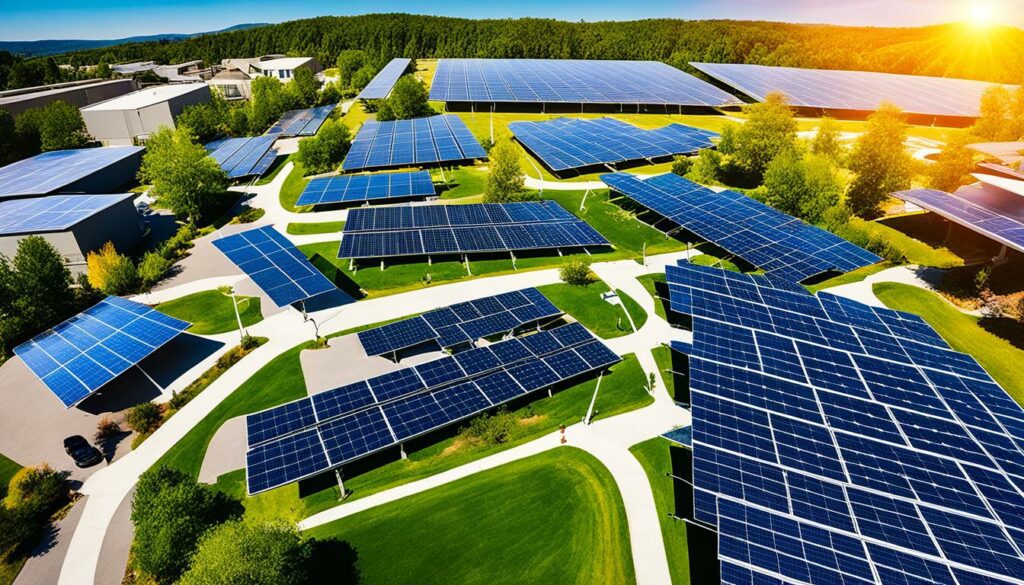
PV cells, or photovoltaic cells, are key in solar tech. They turn sunlight into electricity using materials like silicon. As of 2020, the world had added 710 GW of solar power, with 125 GW added that year. Prices for solar panels fell by 93% between 2010 and 2020, making solar power more affordable. This helped PV cells power not just homes but also gadgets, showing their importance in green energy.
Mirrored solar solutions, like CSP systems, are a big step in solar energy. They concentrate sunlight with mirrors to create electricity. By 2020, the world had nearly 7 GW of CSP capacity, a five times increase from the previous decade. These systems can store energy for up to 12 hours. This makes them a good fit with other renewable sources like wind power. Most CSP systems use parabolic troughs or solar towers, which were one-fifth of all CSP by 2020.
The following table shows important solar energy sector trends:
| Parameter | 2010 | 2020 |
|---|---|---|
| Total Installed PV Capacity | Approximately 40 GW | 710 GW |
| Annual PV Capacity Addition | Less than 20 GW | 125 GW |
| Solar Module Price Reduction | 0% | 93% |
| Installed CSP Capacity | 1.4 GW | 7 GW |
| Cost Decline for Utility-Scale Solar PV | N/A | 85% |
These advancements are crucial for our move towards clean, sustainable energy.
Passive solar energy solutions make the best use of sunlight naturally, in building designs. They work without needing machines. These designs combine various important features.
Green roofs are a fantastic idea. They grow plants that make the air cleaner and soak up rain. They also help keep the house warm in winter and cool in summer. This leads to using less energy, which is good for the planet. Cool roofs use special materials that don’t get hot easily. They reflect the sun’s heat away, keeping the inside of the house cooler in summer.
| Design Feature | Benefits |
|---|---|
| Green Roofs | Improves insulation, reduces heating and cooling costs |
| Cool Roofs | Reduces thermal absorption, lowers summer energy costs |
Radiant barriers are also key in passive solar designs. They’re usually made of aluminium. Instead of getting hot, they reflect heat. This means you might not need as much air conditioning in hot weather.
Overall, using green roofs, cool roofs, and radiant barriers is great for saving energy. These ideas are important for making the most of natural resources. Adding them to new or existing buildings can save money and help the environment over time.
Wind energy solutions are key to mixing our energy mix and fighting climate change. They get better with new renewable energy equipment. This makes wind turbines work better and be more dependable. It’s great to note Vestas is a leader in the wind sector in North America. They’ve set up turbines of 45,000 MW in the U.S. and Canada.
They look after more than 40,000 MW in these areas too. Vestas has over 5,000 team members. They work hard to make, set up, and look after both onshore and offshore turbines. They will spend $1.9 billion in the U.S. supply chain by 2023. It will involve more than 1,200 suppliers. In Canada, they will invest $66 million with about 200 suppliers. Also, they aim to put $40 million into factories in Colorado. This will help make the V163-4.5 MW turbine and create 800 to 1,000 new jobs.
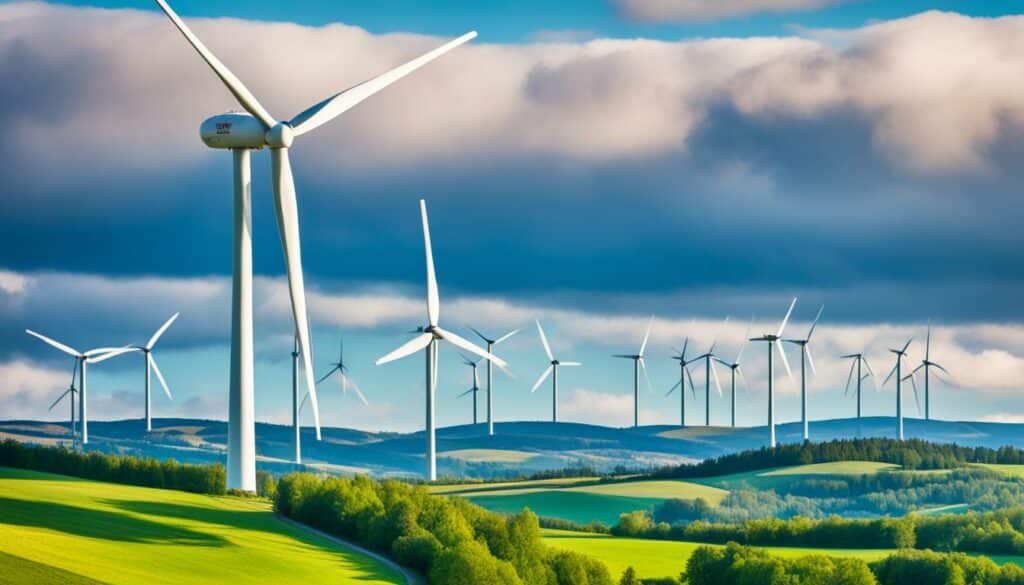
Using wind energy solutions saves money and helps our planet. Wind-powered tools and smart home tech can cut utility bills by half. A home turbine with an average wind speed of 14 mph can make about 300 kWh of electricity each month. This is enough for a home. A 1.5 kW turbine can power a house well, including its security systems.
The wind energy sector is always finding new ways to improve. It’s looking at better materials and designs for turbine blades. These help make wind turbines easier to use and cheaper. The industry also works hard to lessen its impact on nature. It does this by creating systems to warn and protect wildlife. This includes birds and bats, from getting hurt by turbines.
More and more, offshore wind power is growing. The U.S. aims to have 30 gigawatts from offshore wind by 2030. This, along with onshore wind solutions, shows how important wind power is for our green future. Wind turbines make the most of the wind in many places. This gives us a stable and clean replacement for fossil fuels.
Geothermal energy systems are an effective and sustainable way to use the Earth’s heat. These systems use the steady temperature under the ground’s surface. This is great for heating and cooling homes, offices, and bigger places.
Geothermal heat pumps (GHPs) are a key part of these systems. They work by using the ground’s stable temperature for heating and cooling. GHPs can be more than four times more efficient than regular systems during winter. For instance, a geothermal system from Geothermal Energy Solutions, Inc. in Illinois could pay for itself in just three years because it uses less energy.
In some places, using underground steam directly can make electricity. This is a clean way to produce power in areas with natural steam. The U.S. Department of Energy is pushing for more use of geothermal heating and cooling in local areas. In the U.S., these systems could eliminate the need for over 24,500 miles of new power lines by 2050. This shows a way to a cleaner energy future.
| Feature | Geothermal Heating and Cooling | Air Source Heat Pumps | Electric Resistance Heating |
|---|---|---|---|
| Energy Consumption Reduction | Over 40% | Baseline | 70%+ compared |
| Efficiency (Heating Season) | 400%+ | 100%-200% | 100% |
| Maintenance Requirements | Low | Medium | High |
Geothermal systems offer a bright future for sustainable energy. From small heat pumps to big steam plants, they reduce energy use. With their efficiency and low maintenance, these systems prove the power of clean energy. They show the way to meet our environmental goals in the future. As we get better at using sustainable energy, geothermal energy is leading the way.
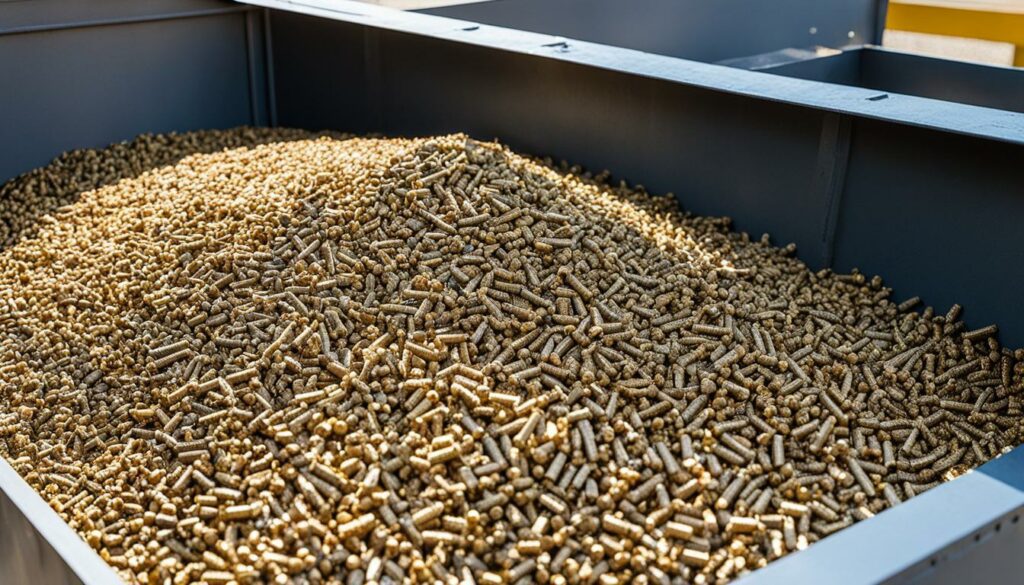
Biomass energy comes from leftovers like wood scraps, farm waste, and leftovers from making things. It turns the sun’s energy into a form we can use. How well we can turn it into energy depends a lot on the special machines we use.
Special methods need certain types of leftovers to work best. Important care should be given to how we handle these leftovers from the start. Picking the right machines and looking after them is key to success.
Lee Enterprises Consulting has many experts around the world in renewable energy. They help with everything from checking how good ideas are, to finding if there’s enough waste to use, to helping with money and understanding the market. Their engineers look at every angle of a project to make sure it’s a good idea and works well.
They work with friends in insurance, law, finance, making plants, and getting leftovers. This team effort makes green energy projects better, from machines that turn waste into gas to making clean fuels.
Meyer Industrial is known for great machines that move waste safely, like valves and pumps. They focus on making their equipment work well and last a long time. Their staff knows these machines inside out to keep them working perfectly.
Working with waste can be dangerous because it can catch fire or explode. Places that work with waste wood and other plants use machines to capture the dust in the air. This keeps everyone safe and helps the machines work better too.
These machines are also good for the planet and make it cheaper to run the business. To make everything work well and safe, good equipment and systems are a must.
Hydroelectric power plants play a big part in low-carbon energy solutions. In the United States, they make up 28.7% of renewable electricity. They also provide about 6.2% of the country’s total electricity. States like Washington, Idaho, and Oregon benefit the most, with Washington getting 66% of its power from water in 2020. Thanks to this, they have lower energy bills than the rest of the country.
The success of a hydroelectric plant depends a lot on its dams. When it’s being set up, there’s a lot of work to do. This includes putting up dams, tunnels, and other things, as well as getting the machinery to work. Even though it costs a lot to start, these systems last a long time. That makes them cheap to run over the years.
| Category | Components |
|---|---|
| Hydraulic Structures | Dams, Spillways, Headworks, Surge Tanks, Penstocks |
| Water Turbines | Impulse Turbines (Pelton wheel), Reaction Turbines (Francis, Kaplan) |
| Electrical Equipment | Alternators, Transformers, Circuit Breakers |
Dividing things into categories helps everything work better together. It turns water’s power into electricity. This keeps the hydroelectric plant working well and dependably.
Though hydroelectric power is good for the environment, building dams has its downsides. Making reservoirs can flood and change the areas around them. It also moves people out of their homes. It’s really important to plan well and work to lessen these bad effects.
There are other issues too, like silt building up and checking if the plants will last a long time. Making sure to think about these things is key to keep hydroelectric power a good choice for the future.
This type of power can also help other renewable sources grow by 2035. Studies suggest it can support over 24 GW of new power. This flexibility is necessary for the future, as the world needs more and more clean energy.
In short, hydroelectric power is crucial for creating eco-friendly power systems using water’s natural power. By building effective dams and being careful about the environment, this kind of energy remains an important choice for our future.
The big movements of the ocean have a lot of power. We’re using this power to make clean energy. The ocean’s tides and waves give us steady energy. It changes how we think about green power.
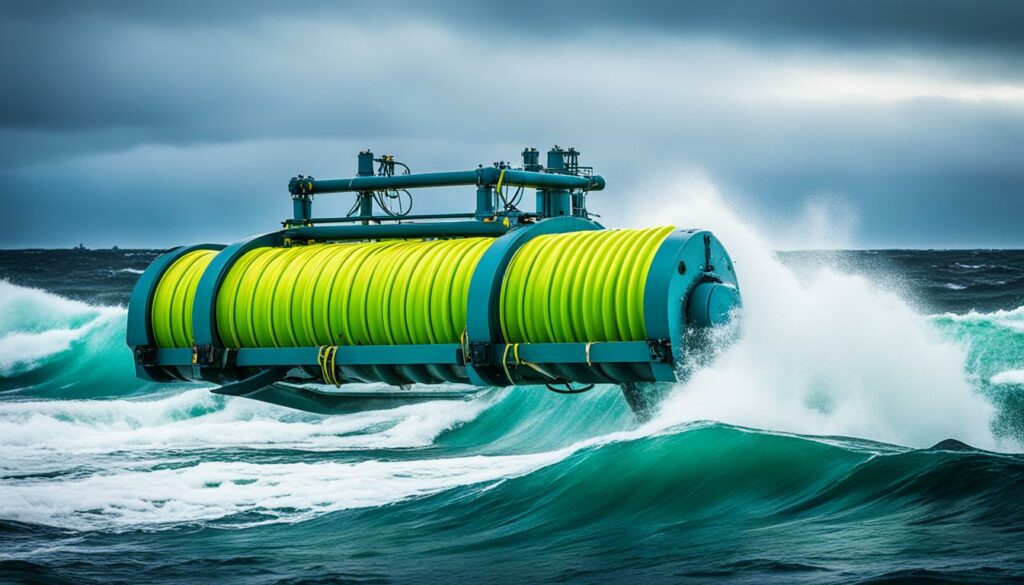
Tidal energy has been around for a while. The world’s first tidal power station was in Northern Ireland in 2007. Tides there move very fast, showing great power. Since 1966, France has been using a tidal power plant. It shows these projects last and are good for the earth. The biggest tidal power station is in South Korea. More countries are starting to use their tides for energy like China and Canada.
| Country | Notable Projects | Potential |
|---|---|---|
| Northern Ireland | Strangford Lough Tidal Power Station | 4 meters/sec tidal movements |
| France | Rance River Plant | Utilises both tidal and river currents |
| South Korea | Sihwa Lake Tidal Power Station | Largest tidal facility worldwide |
| China | Yalu River Tidal Lagoon | High potential at border with North Korea |
| Wales | Swansea Bay Tidal Lagoon | Promising small-scale project |
Wave energy is also full of promise. It uses the move of ocean waves for power. There are new inventions like static turbines and floating devices. They catch the energy of waves. One idea is to build big dams reaching 50 kilometers into the sea. This shows how much we can do with wave energy.
Tidal and wave energy are making big changes in how we get green power. As we find more ways to use the ocean’s power, we get closer to clean, renewable energy.
Algal fuel offers a fresh way to create energy from plants like algae. This approach is gaining attention for being good for the planet and for how well it works. For example, the newest algal fuel cells are now five times more powerful than earlier versions. A new type of cell has reached a power density of 0.5 W/m2, which is a big step forward.
Even though silicon solar cells can turn sunlight into electricity better, algal cells have special benefits. They are not as strong as traditional solar cells, but they allow energy farming even on land not good for crops. This way, we can make fuel without taking away land from growing food.
Big groups like the Leverhulme Trust believe in algae biofuels and are supporting their development. Dr. Paolo Bombelli has shared this work with the public in many places, showing a real dedication to its progress. Studies by experts like Borowitzka MA have helped set the stage for today’s work on algal fuels.
Some studies show that algae can help reduce CO2 from the air, and they are good for making biodiesel as well. Now, scientists are looking for the best algae and ways to grow them for more fuel. Surprisingly, these special algae can be up to 20 times more productive than normal crops for making fuel.
Algae-based fuels are becoming more than a science project. They’re turning into a key part of the effort to have cleaner energy. With the success in growing strong algae and the use of high-tech monitoring, we might see this becoming a real business. Many think it could be a good way to make fuel while keeping the planet healthy.
In the end, biofuel made from algae could be a big help in making industries cleaner. With more study and effort, these solutions could play a big role in our energy future. They show a way to have power that is good for the earth and not just feed our need for energy.
| Efficiency Metric | Algae-Powered Fuel Cells | Conventional Solar Cells |
|---|---|---|
| Efficiency Increase | 5x | – |
| Power Density | 0.5 W/m² | Higher |
| Production Land | Non-Arable | Arable |
| Productivity Comparison | 20x Terrestrial Crops | – |
Energy storage plays a vital role in making renewable energy reliable and easy to access. These technologies help balance the ups and downs of renewable power sources. This ensures a constant supply of energy.
Advanced battery systems are key in storing extra energy from when it’s most sunny or windy. For example, in Moss Landing, California, a 300-megawatt lithium-ion battery is doing this job since January 2021. It shows how important batteries are for a stable grid.
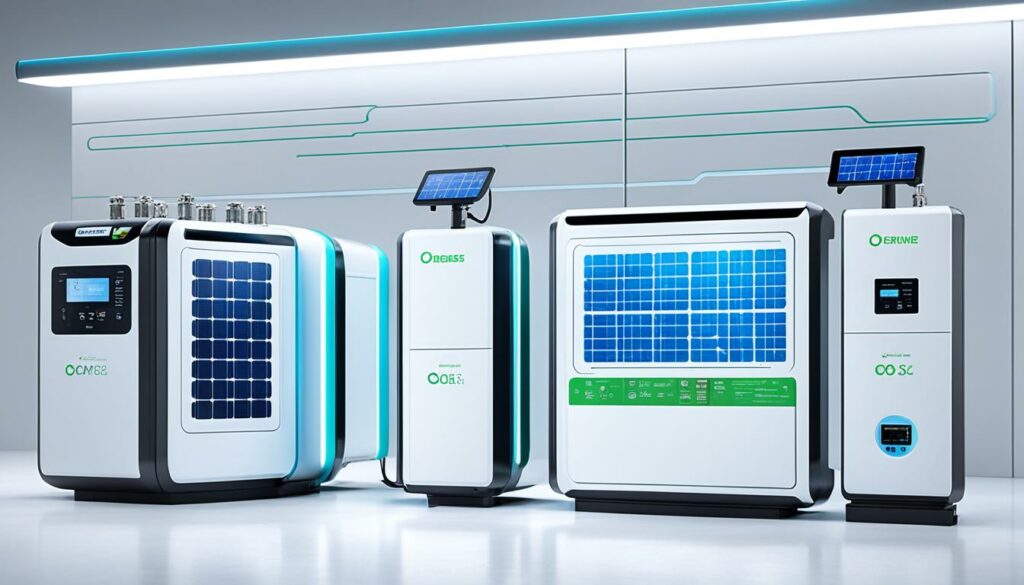
Flywheel systems turn extra electricity into kinetic energy with fast-spinning wheels. They are low maintenance, last long, and are good for the planet. Flywheels work well when quick, powerful bursts of energy are needed, doing their job in 15 minutes or less.
In Finland, an innovative ‘sand battery’ stores heat for long periods. It gathers heat from cheap wind or solar energy. Then, it keeps that heat in sand, ready to warm homes when energy costs are high.
Hydrogen storage is becoming more important for managing energy. It turns extra energy into hydrogen gas using a process called electrolysis. This hydrogen can then be used to make electricity when it’s needed. Hydrogen storage is flexible and works well with other green technologies, making energy use more efficient.
Pumped hydro is a big part of our current energy storage, making up most of it. It works by moving water up to a high place when there’s too much energy. Then, it lets the water down to make hydropower when necessary. This method is very efficient and can store large amounts of energy.
| Technology | Key Features | Advantages |
|---|---|---|
| Lithium-ion Batteries | High energy density, rapidly declining costs | Supports entire electric grid, utility-scale systems fit on less than 0.5 acres |
| Flywheels | High-velocity spinning wheels | Direct electrical generation, long life, low maintenance |
| Hydrogen Storage | Electrolysis for hydrogen gas production | Versatile, eco-friendly power system |
| Pumped Hydroelectric | Gravitational potential energy of water | High efficiency, large-scale energy capacity |
While batteries and hydrogen are top choices today, other tech like compressed air and superconducting magnets are also growing. They offer new paths for storing energy. By improving the way we store energy, we make a stronger and greener future.
Using eco-friendly power systems for homes
Firstly, eco-friendly power systems for homes often start with solar panels. They capture sunlight and turn it into power without harming the environment. Solar PV systems have become more affordable, priced at about $3 per watt. A 7,000-watt setup can cost around $21,000 and meet much of your daily electricity needs.
Also, solar panels can earn you money back. If you make more power than you use, you can get paid through net metering. This not only cuts your bill but also supports the use of solar power.
Adding wind turbines to your home’s power system is another smart choice. For places that get enough wind, these turbines can produce clean electricity. They typically cost about $5 per 120 kilowatts to set up, from $10,000 to $70,000.
Wind turbines work well with solar panels. Mixing both ensures power even when one source isn’t as active. And, just like solar, you can earn credits by selling extra power to the grid.
| Technology | Cost | Electricity Production | Advantages |
|---|---|---|---|
| Solar PV Systems | $3 per watt installed | 20-35 kWh/day | Rebates/Credits, Cost-effective |
| Wind Turbines | $5 per 120 kW installed | Varies | Consistent Output, Hybrid Capability |
Combining residential solar panels and wind turbines for domestic use brings both energy savings and a greener future. These systems give you freedom from traditional power sources and help the planet too.
Using commercial renewable energy equipment can revolutionise how companies approach sustainable power. This technology includes large solar panels, wind turbines, and more. It cuts down on harmful emissions, saves money, and makes energy supplies more reliable.
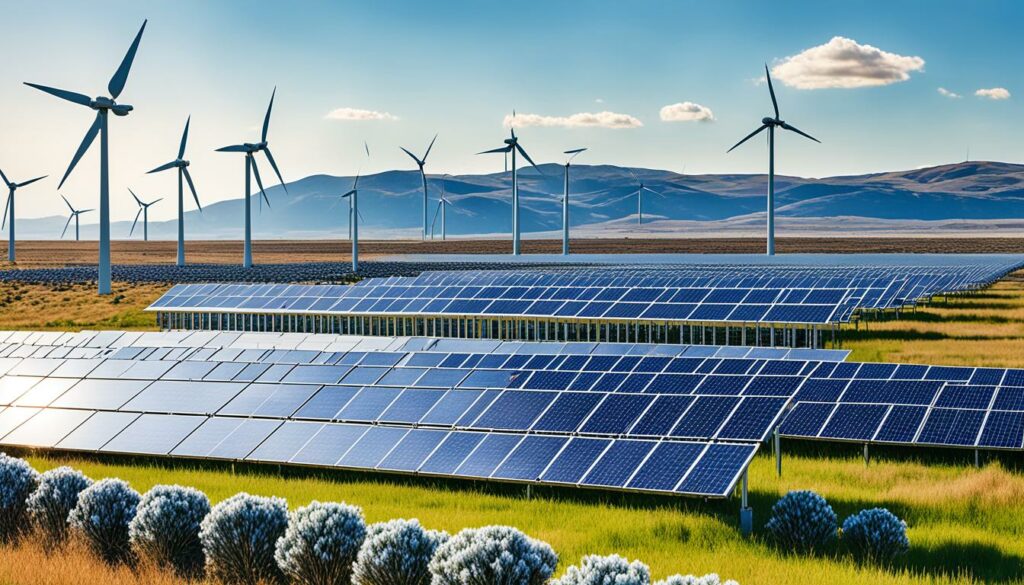
Before investing in this equipment, it’s vital to know the money side of things. Loans for renewable energy can be small, starting from $500, or very big, going into the millions. Paying these loans back might take up to 10 years, with interest rates possibly higher than normal.
Getting to grips with tax breaks is also important. In the U.S., over 30 states offer tax benefits for using solar panels and other green technologies. These can really help save money.
Many countries have used grants and tax breaks to push for more renewable energy. For example, the India Renewable Energy Development Agency (IREDA) gave over $400 million in loans by 2001. This helped make 1600 MW of power from renewable sources.
Stand-alone renewable energy systems need lots of different parts, and some can be expensive. For example, batteries can make up a big part of the total cost. Yet, these batteries are crucial for storing energy when the weather is bad.
When systems are connected to the grid, choosing the right inverter is important for safety. Safety measures like disconnects and surge protectors are also key. They ensure everything runs smoothly and safely.
For any renewable energy system, making sure the power is converted safely is critical. Meters and monitoring equipment also play a big role. They watch over the system, making sure everything works well over time.
Keeping batteries in good condition is also important. Charge controllers are used for this. While equipment like inverters with extra features can increase the cost, they offer valuable insights into your system’s health.
The future of sustainable energy looks bright, with many new inventions coming. This shift will change how we make and use energy, moving us towards methods that are kind to the planet.
New materials and better ways of storing energy will make green power more efficient than ever. For example, the use of solar power is expected to double in a few years. Techniques like floatvoltaics, popular in some countries, use water to cool solar panels.
Advancements in wind power are also impressive. Soon, there will be more onshore and offshore wind farms. Wind turbines’ blades may get as long as 250 meters by 2035, making them work even better.
Geothermal energy is growing fast too. By 2024, it could reach 18 GW. New battery technologies, like lithium-glass batteries, are helping to store this energy more effectively.
Good policies are key to helping new renewable technologies grow. Things like subsidies and tax breaks make it easier for them to be used. California now requires new buildings to have solar panels, a move that helps new energy projects.
The market for green energy is growing. It’s expected to be worth more next year. More and more countries are promising to use a lot more renewable energy soon. By 2024, about 30% of the world’s energy could be green. This is a big change that good policies are helping to make happen.
With new technology and strong policies, it looks like we are on the path to a greener, cleaner future.
Exploring renewable energy shows we can move to a greener future. Both homes and big companies use technologies like solar power. They are changing how we get energy. Plus, there are many ways to get help to go green. Loans can be small or very big, depending on the project size.
Many places around the world offer help to use more green energy. Things like grants, tax breaks, and low-interest loans have helped a lot. In India, for example, over US$400 million in loans helped make 1600 MW of green power.
Yet, there are still challenges. Green energy investments can sometimes cost more because they’re seen as riskier. Places that want to use more green power must think about what kinds of energy are available. Also, some places have old habits, like using more coal and hydro power.
To move forward, we need to keep finding new ways to fight climate change. Using more green energy is a big part of this. It’s about everyone working together to make our energy clean. Overcoming the difficulties and making the most of green energy will lead us to a better future.
Renewable energy comes from natural sources that constantly renew. Wind, sunlight, and heat from the Earth are examples. These resources provide clean energy and never run out.
Solar power is captured by solar panels that change sunlight into electricity. Mirrors can also direct sunlight to create power. Buildings can use clever designs to make the most of the sun’s heat without using machines.
Wind turbines, or windmills, turn wind into electricity. They are good for the environment and cost-effective. However, some places might not get enough wind, and it could affect wildlife.
Geothermal power uses heat from below the Earth’s surface. Machines like heat pumps help control building temperatures. In some places, hot steam is used to make electricity. It’s clean, but it’s not possible everywhere and needs water in the ground.
Biomass gets power from plants and animal waste. It creates electricity by burning these materials. This type of energy must be managed carefully to avoid using too much land or causing pollution.
Hydroelectricity uses the energy of moving water to make power. Dams are often built to capture the water’s energy. The downside is that building dams can harm the environment.
Tidal power uses the movement of the sea to generate electricity with turbines. Wave energy does the same with ocean waves. These methods have great potential but need to be carefully designed.
Algal fuel is a type of biofuel made from algae. It can be turned into biodiesel. Algae grow fast and can be farmed on land that can’t grow food. There is a lot of research on how to make this fuel more common.
Storing energy is important when it comes from sources like the sun or wind. Batteries and making hydrogen from extra energy are ways to do this. These methods help us use renewable energy all the time.
Homeowners can use solar panels and wind turbines to produce their own energy. This lets them live more sustainably and be less dependent on power networks.
Businesses can use solar panels, wind farms, and more for their energy. These big systems help the environment, save money, and make energy sources secure. This is good for business and the planet.
The future of clean energy looks bright. New technologies, smart power use, and worldwide agreements are helping. They support the growth of renewable energy, making the Earth a better place.